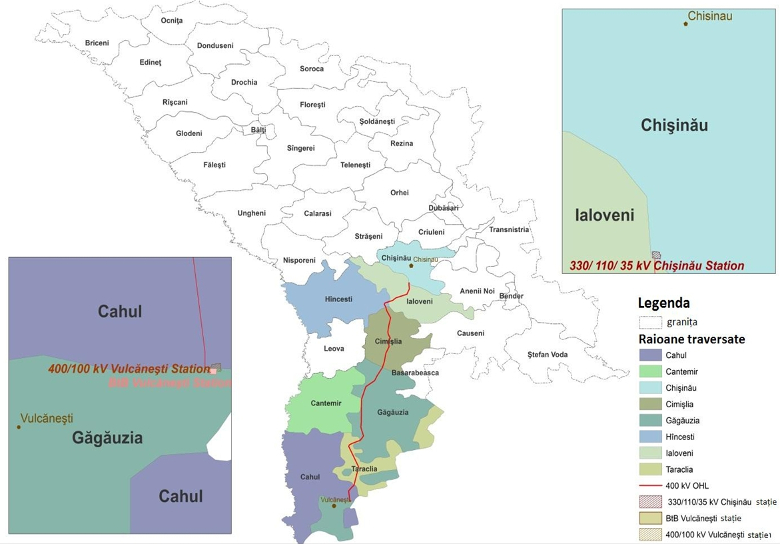|
Objectives |
The asynchronous interconnection of Moldova and Romania electricity grids represent an important step forward towards the integration of the European single electricity market. This process will allow participation of the Republic of Moldova to the European electricity market - through connections with the European grid (“ENTSO-E”).
|
|
Scope of Work |
Part 1: Feasibility assessment and ESIA of the 1st Priority Project
A: Back to back (BtB) station at Vulcănești and OHL 400kV Vulcănești-Chișinău
Part 2: Feasibility assessment and Development Plan of the two 2nd Priority Projects
B: Back to Back station and OHL 330/400 kV Romania -Ungheni-Strășeni
C: Back to Back station and OHL 400 kV Bălți-Suceava
|
|
Client |
|
MOLDELECTRICA State Enterprise
|
|
Consultant Consortium |
-
ISPE – Institute for Studies and Power Engineering, Romania - Coordinator
-
ICPT "Energoproiect", Republic of Moldova
-
IVL Swedish Environmental Research Institute, Sweden
|
|
Duration and Project Category |
Category “A” project
-
Planning stage: 20-24 months
-
Feasibility assessment and ESIA of the 1st Priority Project (subject for this document)
-
Implementation stage; 4 years
-
12-15 months - Procurement process, Engineering & Design, Permitting, Land acquisition
-
27 months – Construction, including working site preparation, tests and commissioning
-
Operation & Maintenance stage: 30-40 years
-
Decommissioning stage: 3-10 months
|
|
Expected Results |
-
Inception and interim reports
-
Feasibility Studies Reports
-
Grid System Study Report
-
Economic and Financial Analysis
-
Disclosure Package:
-
ESIA Report (Environmental and Social Impact Assessment)
-
E&S Management and Monitoring Plan (ESMMP)
-
Non-Technical Summary (NTS)
-
Stakeholder Engagement Plan (SEP)
When financing funds will be available the Project will evolve from planning to the implementation stage (basic & detail engineering, permitting, construction and equipment’s assembling, commissioning and operation). |
|
|
|
Key Issues Studied and Mitigated |
The project analysed in terms of technical & economic feasibility and environmental & social impact assessment the followings:
-
400 kV back to back (BtB) station at Vulcănești, as result of the asynchronous interconnection of Moldova and Romania electricity grids;
-
OHL 400 kV between Vulcănești – Chișinău stations;
-
330/110/35 kV Chişinău station retrofitting and adaptation, due to the new 400 kV voltage.
Three route options were investigated in order to choose the optimal route for the future 400kV OHL. Based on a multi-criteria analysis - option 1 (Figure 1) was decided as the preferred route for Vulcănești – Chișinău 400 kV OHL:
-
Technical (e.g. OHL length; co-existence with other investment objectives as roads, railways, water streams, OHL, telecommunication lines, pipes, etc.; route accessibility or level of difficulty; investment costs etc.)
-
Socio–economic (e.g. access to land; deforestations; landownership when crossing communities and different productive farm lands, vineyards; resettlements or compensations; temporary impact on air quality (dust and particulate matter), noise due to increased intensity and volume of the traffic during site preparation and construction etc.)
-
Environment (e.g. crossing protected areas forests, ravines, rivers and lakes; electromagnetic fields’ impact; ecological systems, flora and fauna impact; visual impact etc.)
-
Cultural heritage (e.g. impacts on cultural buildings, monuments or areas; by-passing archaeological sites etc.)
The rationale for choosing the present option was minimization of all potential impacts generated by the project (e.g. land clearance and deforestations; impacts on cultural heritage and monuments; resettlement and/or compensation; loss of assets and economic displacement). |
|
Stakeholders |
-
Government and Policy Makers
-
Regulatory Authorities
-
Local and Regional Authorities
-
Projects Developers and Investors, Financing Bodies
-
R&D Institutes and the Academic Environment
-
NGOs
-
Local Community; vulnerable citizens who could be affected by the future construction and operation of the OHL
-
Mass-media
|
|
For further information: |
During the public consultation meetings participants will receive from the organizers a feedback form for questions - after completing, it will be submitted to the meeting secretary/registration desk.
Additionally, after these public consultation meetings, any comments or concerns can be brought to the attention of MOLDELECTRICA verbally (by phone) or in writing (by post or e-mail) or by filling in a grievance form. The grievance form will be made available in the mayor’s office, schools, community centres and other public places that are easily accessible for all relevant stakeholders.
Both Forms (Feedback and Grievance) can also be downloaded from MOLDELECTRICA website www.moldelectrica.md
Project Manager: Veaceslav Zastavnețchi, Moldelectrica General Vicedirector
[email protected]
Environmental and social issues: Nelly Melnicenco [email protected], ph. 00373 (22) 253396
Technical issues: Octavian Ciobîrca [email protected] |
|


